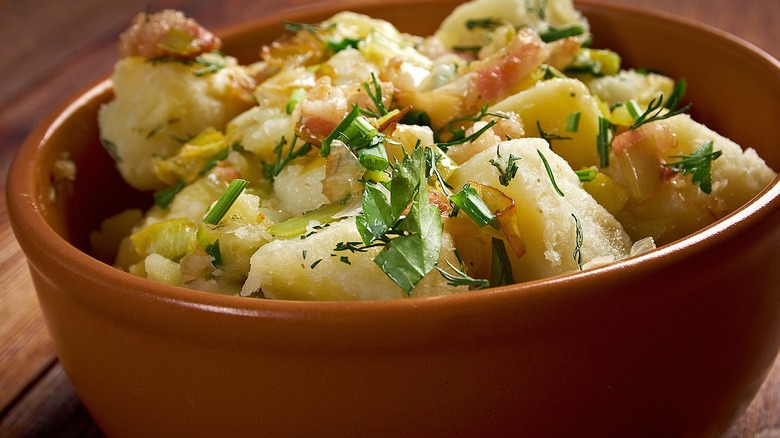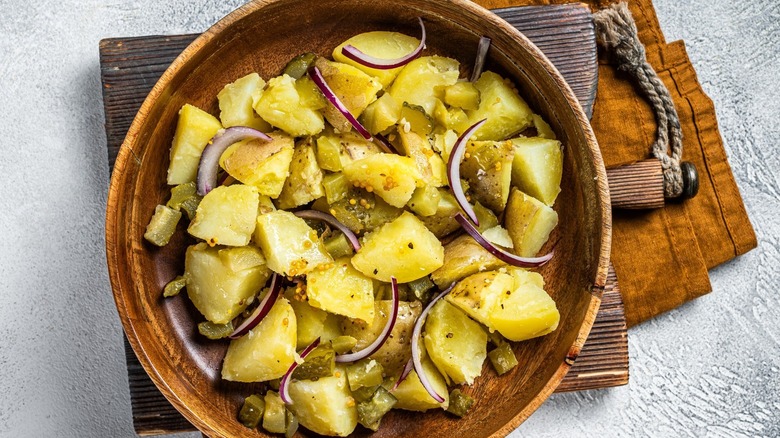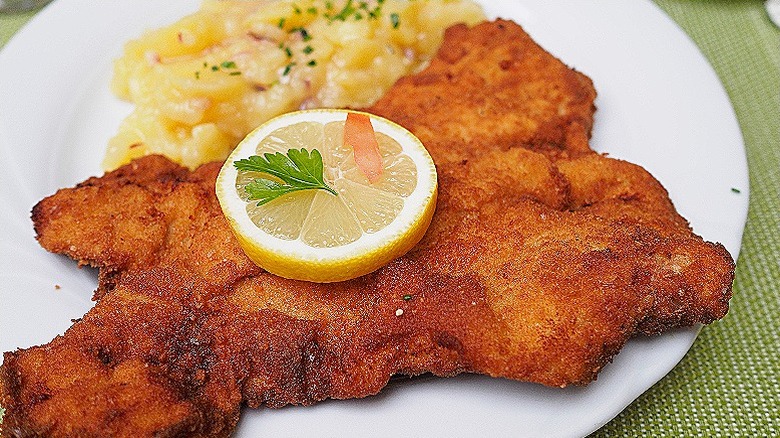The Ingredients That Make German Potato Salad Unique
Everybody knows what a potato salad is. It's that bowl of fluffy potato pieces, drenched in mayonnaise and seasoned with herbs and spices, that you'll find at just about any picnic or cookout you'll ever attend. Maybe it'll have some boiled eggs in it. Maybe it'll have some raw vegetables, like celery, for added crunch. Maybe the person who made it tried to get cute and threw in something like raisins. What really matters — what really makes it a staple — is that it is cold. It is a substantial yet refreshing side dish for a warm summer's day, something that nicely contrasts with burgers and hot dogs fresh off the grill.
But what if that's not the case? What if there was a potato salad made not with mayonnaise, but with vinegar? What if it was accompanied by little bits of bacon? And what if — heavens to Murgatroyd! — it was served warm? That's where German potato salad comes in.
Why is German potato salad so different?
Technically, both of the main potato salad varieties are German. When we say "German potato salad", we're talking about South German potato salad. The dish forgoes mayonnaise in favor of a vinaigrette, with accouterments including onions and bacon (including the drippings), and is served warm rather than cold. There were, in fact, a number of different varieties of German potato salad depending on the region, but the closest relative to what Americans know as German potato salad is Bavarian or Austrian potato salad, aka Erdӓpfelsalat.
This was the first sort of potato salad found in American cookbooks, brought over by immigrants from South Germany. But soon enough, Northern Germans made their presence known in America, and the cold, mayonnaise-based potato salads they favored grew in popularity. In fact, Richard Hellmann (yes, that Hellmann) was a North German immigrant, hailing from the town of Vetschau in Brandenburg. Eventually, the mayonnaise-based potato salad was assimilated and became the default, "American" kind of potato salad, while its warm counterpart has the "German" modifier attached to it.
When do you serve German potato salad?
The obvious move would be to serve regular potato salad in hot weather and German potato salad in cold weather — much as a nice gazpacho will taste much better on a Mediterranean beach than it will in the Siberian wilderness. If you're attending a cookout in July and you're asked to bring something to eat, a big creamy bowl of cold potato salad would be more than welcome. If, on the other hand, you're looking for a side dish to serve with pork tenderloin in November, German potato salad would be a good choice.
But in truth, German cuisine has no truck with the kind of fussiness that makes you worry about which dishes to serve at what time. Both varieties of potato salad go wonderfully with meat (German potato salad is often served with schnitzel, or schnitzel in sandwich form), and if it's made right both can be satisfying in their own right. If it sticks to your ribs and soothes your weltschmerz, you can eat it at any old time you like.


